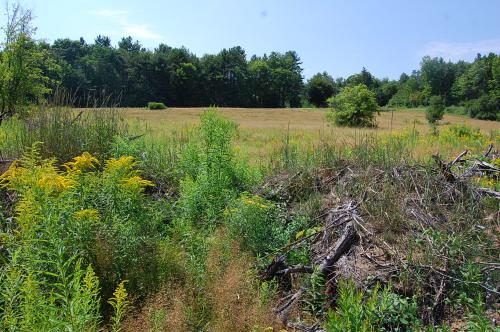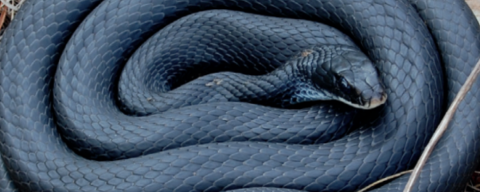Black racers are slender, agile snakes that can grow to 6 feet in length. True to their name, they are solid glossy-black except for a white throat and chin, and they can move incredibly fast! Young racers are patterned with brown or reddish patches on a lighter base of gray, and fade to solid black after 1-2 years of age.
Racers are very active snakes and may travel large distances. They rarely remain in one location for more than a week and typically move several miles throughout the summer in search of mates, food and basking locations. During the winter months, they tend to hibernate in congregations in chipmunk burrows or rocky hillsides. Although large, black racers pose no danger to humans or pets. Like any animal, racers may act defensive when they feel threatened, but their first choice is to flee when encountering people or pets.
Did you know..?
- Racers are good climbers and can occasionally be found in trees as high up as 30 feet.
- Contrary to their scientific name, Coluber constrictor, racers do not constrict their prey. They simply bite and swallow whatever they can catch − mice, birds, snakes, frogs, or insects.
Habitat

Racers prefer open, shrubby habitats. These are often referred to as early successional or “shrubland” habitats and are used by more than 100 wildlife species. Racers typically rely on large patches of shrubland habitat like old fields, powerline corridors, regenerating clearcuts, or the soft edges of agricultural fields.
In the absence of larger shrublands, racers will use smaller habitat patches like backyards, forest openings, and even features introduced by human development like rip-rap slopes or junk piles.

In your backyard
A yard with areas of dense or overgrown vegetation and man-made features like stone walls, wood piles or stick piles are more attractive to snakes and other wildlife compared to manicured yards. These more ‘structurally diverse’ yards attract prey like mice and smaller snakes, and also make nice spots for shedding or for females to lay eggs. While racers will often move between several yards each year, they are likely to spend more time and return year after year in those yards with high structural diversity.
A Species in Decline
Black racers are less common than they were 50-100 years ago, with small populations scattered across the southern half of New Hampshire. The few remaining large populations persist at sites where suitable habitat has been maintained for decades. Racers are a state-threatened species, and are considered a Species in Greatest Need of Conservation in the NH Wildlife Action plan.
Threats to Black Racers

Human Development. As New Hampshire’s human population grows, much of the state’s shrubland habitat has been lost or fragmented by development into parcels too small to provide the best habitat for black racers. A reduction in habitat quality or availability forces racers to move longer distances to find suitable habitat. Increased movement is likely to increase road crossings or encounters with humans, both of which can result in snake mortality.
Forest Succession. There was an abundance of early successional habitat in the decades following large-scale abandonment of farmlands in New Hampshire (1900s-1960s), which probably allowed black racer populations to thrive. Over time, these habitats have naturally aged and reverted back to mature forests, resulting in a decrease in the quantity and quality of available habitat for racers.
Encounters with People. Because racers may use backyards when larger habitat patches are unavailable, they are vulnerable to being killed by pets, intentionally by homeowners, or accidentally when they are hit by lawnmowers and vehicles. Nesting females might be found in gardens, mulch beds or wood piles, which are attractive nesting spots. Females may nest communally and use the same area each year, which increases the threat to a population if homeowners are fearful of and kill snakes. Human encounters that result in mortality can lead to population declines and even local extinctions over time.
How You Can Help
Leave them where they are. For those that are fearful of snakes, remember that racers are very active and are unlikely to remain in the same area for an extended period of time. And just because a snake lays eggs in a yard doesn’t mean there will be an increase in snakes seen locally in future years – young snakes have several predators and many don’t survive to adulthood. If you can’t tolerate them, don’t kill them – black racers are protected under New Hampshire’s Endangered Species Act. Instead, maintain a manicured lawn near your house and play areas. Short grass and limited places for hiding will likely reduce food sources and deter snakes and other wildlife.
Protect snakes from your pets. On conserved lands and areas known to be frequented by racers, keep dogs leashed to minimize the potential for snakes to be injured or killed. Keep cats indoors to protect young snakes and a variety of other wildlife species.
Maintain or enhance existing habitat. A yard that is frequented by racers each year is likely to be an important habitat for the local population. You can help maintain a healthy racer population by maintaining the conditions you have or enhancing the habitat. Let the grass grow long, plant native shrubs and leave stick and rock piles for cover.
Conserve your land. Minimizing future habitat loss in areas where black racers are known to occur is vital to the conservation of the species. Help conserve important natural areas in your community, or put your land into a conservation easement to help ensure that it will never be developed.
Help Keep Racers Safe

- If you are planning to burn or move a brush pile, do it soon after it’s created or wait until fall or winter to reduce the chances a snake may be using it.
- Keep aware while mowing your lawn, particularly if the grass has grown tall. Racers and other snakes may react slower than expected to oncoming lawn mowers.
- Avoid using erosion control netting and other landscaping netting made of plastic—snakes and other wildlife are easily trapped in it often leading to death.
Additional Information
For more information on black racers, visit www.wildnh.com/nongame
Reptile and Amphibian Reporting Program. Biologists use your reports of black racers to help understand their distribution in the state. Report any reptile or amphibian species to NH Fish & Game in one of three ways:
- Online at nhwildlifesightings.unh.edu (preferred by NHFG)
- Send photograph, exact location and date to RAARP@wildlife.nh.gov
- Send photograph and sighting information to 11 Hazen Drive, Concord NH 03301, C/O RAARP - Wildlife Division.

We bring information about NH’s wildlife to you! The Taking Action for Wildlife Team, made up of staff from both NH Fish and Game and UNH Cooperative Extension, works to help towns, land trusts, natural resource professionals, and private landowners conserve wildlife and habitats in New Hampshire. We help put information from NH’s Wildlife Action Plan in the hands of New Hampshire citizens.
For more information about habitat management, resources and publications about other wildlife, and to learn more about the New Hampshire Wildlife Action Plan visit www.takingactionforwildlife.org
Download resource for printable brochure.
This webpage and accompanying Focus on Wildlife brochure was developed by UNH Cooperative Extension and NH Fish & Game.Written by Haley Andreozzi and Brendan Clifford. June 2015.
Photo Credits: Brendan Clifford – NHFG

